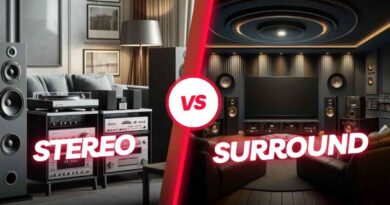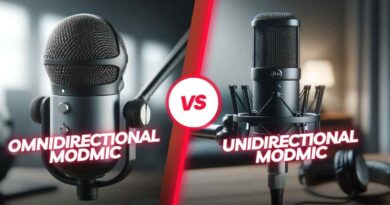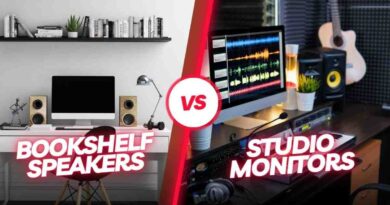IEMs vs. Headphones: Which Is Better?
You’ve got your music library prepped, but choosing how to listen to it can be a whole other headache. In one corner, we have the in-ear monitors (IEMs), sleek and compact, perfect for slipping in your pocket. In the other, the classic over-ear headphones, offering plush comfort and a potentially more immersive experience.
But which is right for you? Do IEMs deliver the same sound quality while sacrificing comfort? Can headphones really block out all the noise, or do they make your ears sweat like crazy? This throwdown will settle the score by exploring the strengths and weaknesses of both IEMs and headphones, helping you pick the perfect match for your listening style and needs.
IEMs Vs. Headphones – The Basics
Understanding the fundamental differences between IEMs and headphones is essential for making an informed choice. Both serve the purpose of delivering audio directly to your ears, but their design, use cases, and audio delivery vary significantly.
What Are IEMs?
In-ear monitors (IEMs) are compact earbuds designed to fit snugly inside the ear canal, offering an isolated listening experience by blocking out external noise. They are favored by musicians and sound engineers for their ability to provide clear, accurate sound directly into the ear with minimal interference. IEMs are particularly known for their portability and noise isolation, making them a popular choice for commuting, casual listening, and even on-stage performances.
Key Specifications:
Driver type: Usually uses balanced armature drivers for precise sound reproduction.
Isolation: Provides excellent isolation due to deep ear canal insertion.
What Are Headphones?
Headphones are larger devices that either sit on top of the ears (on-ear) or encompass the ears (over-ear). Known for their comfort and sound quality, headphones are widely used in a variety of settings from professional studios to everyday casual listening. They typically have larger drivers compared to IEMs, which allows them to produce richer and more dynamic soundscapes.
Key Specifications:
Driver size: Ranges from 30mm to 50mm for more expansive sound reproduction.
Comfort: Generally more comfortable for long listening sessions due to their size and padding.
Key Takeaways:
- IEMs offer superior noise isolation and portability, ideal for travel and stage use.
- Headphones provide better sound quality and comfort, especially suited for home and studio use.
Design and Build Quality
The design and build quality of audio devices significantly affect their performance, comfort, and durability. Let’s explore how IEMs and headphones stand in these aspects.
IEMs: Precision Engineering in a Compact Form
IEMs are designed to be as compact as possible while still providing high-quality audio. They often feature multi-driver systems that include separate drivers for bass, mids, and treble, allowing for precise sound reproduction. The build quality of IEMs is focused on achieving good fit and seal within the ear canal, which is crucial for sound isolation and clarity. Many high-end IEMs are made with durable materials like aluminum, titanium, or custom-molded acrylics for a personalized fit.
Detailed Features:
Multi-driver systems: Can include anywhere from two to over eight drivers per earpiece.
Materials: Often uses high-quality, durable materials and may offer custom molding for a perfect fit.
Headphones: Comfort and Durability
Headphones are built with larger physical components, which generally translates to better durability. They have robust constructions with materials such as plastics, metals, and sometimes even wood. Headphones are designed to be comfortable for long periods, featuring padded headbands and ear cushions that also help in improving passive noise isolation. The larger size allows for the incorporation of larger drivers, which enhances the overall sound experience.
Detailed Features:
Driver configuration: Larger drivers provide a more powerful and dynamic sound.
Adjustability: Typically includes adjustable headbands to fit different head sizes comfortably.
Key Takeaways:
- IEMs are designed for precision and portability, with materials and construction aimed at achieving the best fit and sound isolation.
- Headphones are built for comfort and durability, with larger drivers that enhance audio quality for a variety of uses.
Sound Quality and Performance
The core aspect that distinguishes audio devices is their sound quality and performance. Here, I will delve deep into the acoustic characteristics of both IEMs and headphones, emphasizing their strengths and limitations.
IEMs: Detailed and Intimate Sound
IEMs are renowned for their ability to deliver highly detailed and accurate audio, making them a favorite among audio professionals and musicians.
The sound quality of IEMs is often characterized by a precise, clear reproduction of sound, thanks to their balanced armature drivers which provide excellent response across frequencies. Moreover, because IEMs fit directly into the ear canal, they minimize sound leakage and maintain a consistent audio experience even in noisy environments.
Acoustic Properties:
High frequency clarity: IEMs typically offer superior treble performance due to the precision of balanced armature drivers.
Sound isolation: The in-ear fit provides remarkable noise isolation, which enhances the overall clarity and detail of music, particularly in noisy settings.
Headphones: Rich and Expansive Sound
Headphones, with their larger drivers, are capable of producing a more expansive soundstage than IEMs. This quality makes them particularly suited for enjoying a wide variety of music genres, movies, and games where a broad, immersive audio experience is desirable.
Over-ear headphones, in particular, are able to deliver deep, resonant bass and rich, detailed highs. The open-back or closed-back design also plays a significant role in shaping the audio character—open-back headphones offer a more natural and spacious sound, whereas closed-back models provide better noise isolation and bass response.
Acoustic Properties:
Dynamic range: Larger drivers enable a broader dynamic range, offering a richer and more immersive listening experience.
Soundstage: Typically offers a wider soundstage, which allows for a more immersive experience with a sense of space and depth in the audio.
Key Takeaways:
- IEMs excel in delivering clear, detailed sound with excellent isolation, making them ideal for critical listening and environments with lots of background noise.
- Headphones provide a richer, more spacious audio experience, perfect for home entertainment and professional studio settings where size and portability are less of a concern.
Comfort and Usability
For many users, the comfort and usability of their audio devices are just as important as the sound quality. The differences in design between IEMs and headphones naturally lead to variations in how comfortable they are during prolonged use.
IEMs: Compact and Secure Fit
The comfort of IEMs largely depends on achieving a good seal and fit within the ear. High-quality IEMs often come with a variety of ear tips made from materials like silicone, foam, or even custom-molded tips to fit individual ears.
While the deep insertion into the ear canal can be uncomfortable for some users, the proper fit not only enhances comfort but also improves sound quality and isolation. For active users, such as athletes or performers, the secure fit of IEMs ensures they stay in place during vigorous activities.
Usability Features:
Customizable fit: Multiple ear tip options ensure a secure and comfortable fit for a wide range of ear shapes.
Portability: Due to their small size, IEMs are extremely portable and easy to store, making them an excellent choice for on-the-go listening.
Headphones: Over-Ear Comfort
Headphones are generally considered more comfortable for extended listening sessions due to their over-ear design, which distributes pressure more evenly around the ears rather than inside them. The padding on the ear cups and the headband not only adds comfort but also helps in improving passive noise isolation. However, the larger size and weight of headphones can be a drawback for mobile use or during physical activity, where they may feel bulky or cumbersome.
Usability Features:
Padded comfort: Soft ear cushions and padded headbands enhance comfort for long listening periods.
Adjustable design: Headbands can usually be adjusted to fit different head sizes comfortably, accommodating a wide range of users.
Key Takeaways:
- IEMs offer a secure, customizable fit that is great for active use and travel, though they may require adjustment for optimal comfort.
- Headphones are preferred for stationary use where comfort and ease of wear are prioritized over portability.
Durability and Maintenance
Both IEMs and headphones come with their own sets of durability considerations. Given the investment in high-quality audio devices, understanding how they stand up to wear and tear and how easy they are to maintain is crucial.
IEMs: Delicate yet Durable
IEMs are often seen as delicate due to their small size and the intricate components they house. However, many higher-end IEMs are built with robust materials that can withstand regular use.
The cables, which are often the most vulnerable part, are typically reinforced and, in many cases, detachable, allowing for easy replacement or upgrade. Additionally, because IEMs are used inside the ear, they are more susceptible to earwax and moisture, which means they require regular cleaning to maintain optimal performance and hygiene.
Durability Features:
Reinforced cables: Many IEMs feature cables that are designed to resist tangling and physical wear.
Water-resistant coatings: Some IEMs come with coatings that protect against sweat and moisture, which is especially beneficial for users who wear them during exercise.
Headphones: Robust and Repairable
Headphones are generally more robust than IEMs due to their larger size and the stronger materials used in their construction.
The headband and earcups are often made of durable plastics or metals, and the larger drivers are well-protected by substantial housings. Additionally, many headphone parts such as the ear pads and cables are user-replaceable, which extends the life of the device significantly. Regular maintenance for headphones typically involves cleaning the ear pads and occasionally checking the integrity of the connectors and headband.
Durability Features:
User-replaceable parts: Ear pads, cables, and sometimes even the drivers can be replaced, which greatly extends the lifespan of the headphones.
Sturdy construction: The use of metals and high-quality plastics in the headband and earcups enhances durability.
Key Takeaways:
- IEMs require careful handling and regular cleaning but are designed with replaceable components and protective coatings to enhance their durability.
- Headphones are built to be durable and maintainable, with many models designed to allow easy replacement of parts subject to wear and tear.
Price Comparison and Value for Money
The price of audio equipment often reflects its quality, features, and durability. Both IEMs and headphones can range from relatively inexpensive to high-end, premium prices, depending on their specifications and intended use.
IEMs: A Range of Prices for Diverse Needs
IEMs can vary greatly in price, from budget-friendly options suitable for casual listening to professional-grade models that can cost several hundred or even thousands of dollars. The price typically increases with the number of drivers, the quality of materials, and the inclusion of features like wireless connectivity and active noise cancellation.
For serious musicians and audio professionals, investing in high-quality IEMs can provide excellent sound isolation and fidelity, which are critical during performances or mixing sessions.
Value Considerations:
Multi-driver configurations: More expensive IEMs often feature multiple balanced armature drivers for improved sound quality.
Custom molds: Professional IEMs may offer custom molding for a perfect fit, which adds to the cost but provides unmatched comfort and isolation.
Headphones: Investing in Sound and Comfort
Like IEMs, headphones also span a broad price range. Entry-level models might be suitable for everyday use, while high-end headphones are targeted at audiophiles and professional users, with prices reflecting their superior sound quality and build.
Over-ear headphones, especially those with open-back designs and high-quality drivers, can offer an exceptional listening experience, making them a worthwhile investment for those who appreciate depth and detail in their audio.
Value Considerations:
High-fidelity sound: Premium headphones often feature advanced driver technology and acoustic engineering for superior sound reproduction.
Comfort features: Higher-priced models emphasize comfort with features like memory foam ear pads and ergonomic designs.
Conclusion: Weighing Your Options
Finally, when deciding between IEMs and headphones, it boils down to your individual requirements, likes, and where you’ll use them. If you need discreet, portable listening with great isolation, IEMs are perfect. They’re great for travelers, active folks, and pros who need accurate audio.
On the flip side, if you prioritize sound quality, comfort, and immersive experiences, go for headphones. They shine at home, in studios, and anywhere you can dive into rich sound without worrying about portability.
Frequently Asked Questions
Which is better for professional use, IEMs or headphones?
IEMs are often better for on-stage use due to their excellent sound isolation and fit, while headphones are preferred in studio settings for their sound quality and comfort.
Are IEMs more expensive than headphones?
IEMs and headphones can both range from budget-friendly to high-end; the choice depends on specific features and quality.
Can headphones match the portability of IEMs?
No, headphones are generally bulkier and less portable than IEMs, making them less ideal for frequent travel.
Do IEMs provide better noise isolation than headphones?
Yes, due to their in-ear design, IEMs typically offer superior noise isolation compared to headphones.
Which is more durable, IEMs or headphones?
Headphones usually offer greater durability and easier maintenance, especially with user-replaceable parts.
What should I choose for commuting?
IEMs are more suitable for commuting because of their compact size and excellent noise isolation.
Are headphones suitable for gym use?
Generally, headphones are not recommended for the gym due to their size; IEMs are better suited for active use.
Which provides better sound quality for classical music?
Headphones are typically better for classical music due to their wider soundstage and dynamic range.
Can IEMs be customized for fit?
Yes, many high-end IEMs offer custom molding for a perfect ear fit.
What’s the best option for long-haul flights?
Headphones are ideal for long-haul flights due to their comfort and superior noise isolation capabilities.




